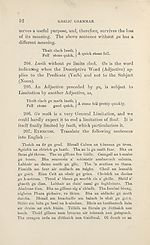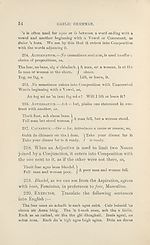Download files
Complete book:
Individual page:
Thumbnail gallery: Grid view | List view

THE FUNCTIONS OF WORDS.
53
fhuaran. Tha an t-astar duilich, cruaidh. Thig laithean frasach,
dorcha, trom. Tha guth na ribhinn ceblmhor. Th^id bean a’
ghreusaiche bho dhorus gu dorus. Tha gruaidh an duine bhochd
gu tana, ban.
208. Labour-Saving Words.—Labour-saving words
are for the purpose of avoiding repetition, e.g.:—
Thuit clacb ague bhris i.
Fell stone and broke it.
!- A stone fell and it broke.
209. Conjunction.—Agus joins the statements thuit
clock and bhris i together. Words which join are called
Conjunctions. Conjunctions are used between two
Verbs, or Predicates, to enable one Noun, or Subject, to
apply to both, as,
Thuit agus bhris clach.
Fell and broke stone.
• A stone fell and broke.
210. Conjunctions are used between two Subjects, or
Nouns, to make one Predicate, or Verb, serve for both, as,
Thuit clach agus maide.
Fell stone and stick.
y A stone and a stick fell.
211. We are enabled by agus to avoid saying Thuit
clach ; thuit maide, and Thuit clach agus bhris a’ chlach.
212. Conjunctions are limited in number, and are
named according to their uses.
213. Copulative.—Agm, contracted to ’m and’s (sometimes
a’>s) = and.
Is is a form which cannot now be differentiated from agus or
its contractions. That it is not a contraction for agus is apparent
in old literature; but there is no reason for retaining it any
longer in the language. No one pretends to know when he is
using ’m (contraction for agus) or is. Its abolition would
remove the difficulty caused by the form is being both a Con¬
junction and a Verb. The spelling of contracted agus as a’s
should be abandoned, because of another a’s which is not a
conjunction.
53
fhuaran. Tha an t-astar duilich, cruaidh. Thig laithean frasach,
dorcha, trom. Tha guth na ribhinn ceblmhor. Th^id bean a’
ghreusaiche bho dhorus gu dorus. Tha gruaidh an duine bhochd
gu tana, ban.
208. Labour-Saving Words.—Labour-saving words
are for the purpose of avoiding repetition, e.g.:—
Thuit clacb ague bhris i.
Fell stone and broke it.
!- A stone fell and it broke.
209. Conjunction.—Agus joins the statements thuit
clock and bhris i together. Words which join are called
Conjunctions. Conjunctions are used between two
Verbs, or Predicates, to enable one Noun, or Subject, to
apply to both, as,
Thuit agus bhris clach.
Fell and broke stone.
• A stone fell and broke.
210. Conjunctions are used between two Subjects, or
Nouns, to make one Predicate, or Verb, serve for both, as,
Thuit clach agus maide.
Fell stone and stick.
y A stone and a stick fell.
211. We are enabled by agus to avoid saying Thuit
clach ; thuit maide, and Thuit clach agus bhris a’ chlach.
212. Conjunctions are limited in number, and are
named according to their uses.
213. Copulative.—Agm, contracted to ’m and’s (sometimes
a’>s) = and.
Is is a form which cannot now be differentiated from agus or
its contractions. That it is not a contraction for agus is apparent
in old literature; but there is no reason for retaining it any
longer in the language. No one pretends to know when he is
using ’m (contraction for agus) or is. Its abolition would
remove the difficulty caused by the form is being both a Con¬
junction and a Verb. The spelling of contracted agus as a’s
should be abandoned, because of another a’s which is not a
conjunction.
Set display mode to:
![]() Universal Viewer |
Universal Viewer | ![]() Mirador |
Large image | Transcription
Mirador |
Large image | Transcription
| An Comunn Gàidhealach > An Comunn Gàidhealach Publications > Scottish Gaelic as a specific subject > (57) |
|---|
| Permanent URL | https://digital.nls.uk/125955701 |
|---|
| Description | This contains items published by An Comunn, which are not specifically Mòd-related. It includes journals, annual reports and corporate documents, policy statements, educational resources and published plays and literature. It is arranged alphabetically by title. |
|---|
| Description | A collection of over 400 items published by An Comunn Gàidhealach, the organisation which promotes Gaelic language and culture and organises the Royal National Mòd. Dating from 1891 up to the present day, the collection includes journals and newspapers, annual reports, educational materials, national Mòd programmes, published Mòd literature and music. |
|---|---|
| Additional NLS resources: |
|

